In recent years, with the rapid development of the photovoltaic industry, the demand for photovoltaic encapsulant particles (EVA/POE) has increased rapidly.
According to statistics, almost all of the world's encapsulant film production capacity is concentrated in China, while China still highly depends on imports for EVA and POE as core packaging materials. In 2021, China's EVA import dependence rate still exceeds 50%, and POE is even monopolized by overseas manufacturers, which basically depends on imports. The rapid expansion of downstream demand and low domestic production rate have brought broad market space for the development of EVA and POE materials.
Types and comparison of photovoltaic encapsulant films
As one of the well-known film extrusion companies, let me introduce the types and differences of films for you in detail. China's photovoltaic industry started early and has a high level of development. It has a high proportion of production capacity in multiple links of the industrial chain, and has become the promoter and leader of global photovoltaic industry development. Especially after the industry restructuring, foreign companies have basically withdrawn from the market in the photovoltaic encapsulant film industry. According to Foster's annual report data, about 90% of the cost of enterprise photovoltaic encapsulant film production is direct raw material cost.
.png)
EVA/POE are the core raw materials used in photovoltaic film, but their domestic production levels are low. As of 2021, China's EVA production capacity is a total of 1.772 million tons, accounting for 27% of the global production; while the global production capacity of POE/POP exceeds 1 million tons. Due to high technical barriers in polymerization process, metallocene catalysts, and alpha-olefins, China has not yet achieved large-scale industrial application of POE.
Currently, there are four main types of photovoltaic film in the market: transparent EVA film, white EVA film, POE film, and co-extruded EPE film. Transparent EVA film manufactured by eva film making machine, due to its price advantage and processing performance advantage, has become the mainstream packaging material, accounting for approximately 52% of the market share.; white EVA film is EVA resin with a certain amount of titanium dioxide and other white fillers added to increase the reflectivity of secondary light. It is mainly used in the back encapsulation of single glass and double glass components. When white EVA is used instead of transparent EVA, the power gain of double glass components can reach 7-10W, and that of single glass components can reach 1-3W.

Market Share of Different Encapsulation Materials (%)
POE film provided by poe film extrusion line is the mainstream encapsulation material for double-glass module due to its unique anti-PID performance, high resistivity and low hydrolysis. EPE film, produced by co-extrusion process of EVA and POE resin, has good processing performance of EVA and excellent anti-PID and water vapor resistance of POE.
According to the forecast by CPIA, the market share of transparent and white EVA film will decline in the coming years, while the market share of EPE film will significantly increase.
Demand for EVA
Thanks to the rapid development of industries such as photovoltaics, the consumption of EVA in China has grown rapidly, reaching 2.053 million tons in 2021, with a compound growth rate of 9.52% in the past five years.
EVA is widely used, mainly in the fields of photovoltaics, textiles and shoes materials, and electrical insulation. The downstream consumption structure includes photovoltaic materials accounting for 37%, foam materials accounting for 28%, cable materials accounting for 17%, hot melt adhesive accounting for 7%, coating accounting for 7%, and agricultural film accounting for 1%. Photovoltaic materials remain the largest downstream consumer, with the potential to expand their share in the future.
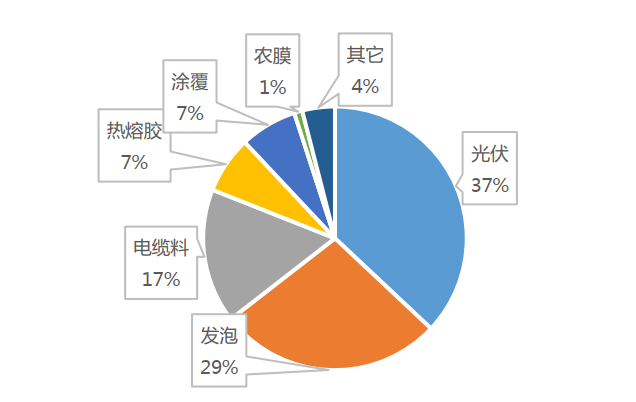
Consumption situation of EVA downstream in China
Based on the forecast of the global PV installed capacity by CPIA and in combination with the trend of the proportion of film materials, the future demand for EVA is estimated as follows:
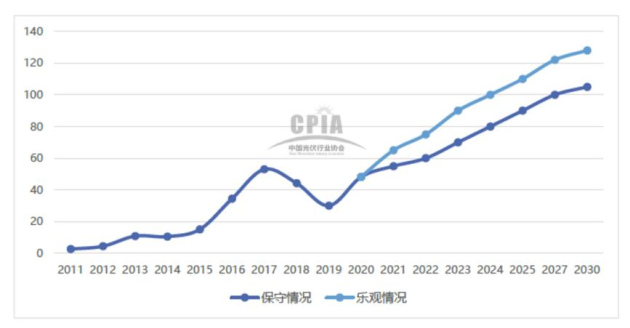
China's annual new photovoltaic installation capacity and forecast (GW)
The demand growth for EVA resin is expected to reach 240,000 tons (in 2021), 210,000 tons (in 2022), 150,000 tons (in 2023), and 100,000 tons (in 2024) respectively, considering the global increase in photovoltaic material production capacity. In 2022, there may still be a supply shortage of photovoltaic materials, indicating a positive outlook.
POE Market Status and Prospects:
Typical representatives of high-end products are polyolefin elastomers (POE) and polyolefin plastics (POP). The total domestic demand is nearly 500,000 tons per year, of which only a small amount of POP can be produced independently, and the rest relies entirely on imports.
Polyolefin elastomers are a type of polyolefin material polymerized from ethylene and propylene or other alpha-olefins (such as 1-butene, 1-hexene, 1-octene, etc.).
Compared with polyolefin plastics, the content of copolymerizable monomers in the molecular chain of POE is higher, and the density is lower. Polyolefin elastomers mainly include ethylene-propylene copolymers and ethylene/alpha-olefin copolymers. Among them, ethylene-propylene copolymer elastomers include two types: EPDM (ethylene-propylene-diene monomer) and EPM (ethylene-propylene monomer). Ethylene/alpha-olefin copolymer elastomers primarily include ethylene/alpha-olefin random copolymers (POE) and ethylene/alpha-olefin block copolymers (OBC).
There is no essential difference between POP and POE, only the difference in the content of copolymerizable alpha-olefin monomers, which leads to a difference in density between POP and POE. Typically, the mass fraction of POE copolymerizable monomers is greater than 20%, while the mass fraction of POP copolymerizable monomers is less than 20%, so the density of POP is higher than that of POE.
Due to its special molecular structure, POE has good rheological properties, mechanical properties, UV resistance, and low-temperature toughness. At the same time, it has good affinity with polyolefins and is widely used in the field of polymer modification and film preparation.
From the perspective of end applications, the domestic market is mainly dominated by the automotive industry, accounting for 68% of consumption, followed by the polymer modification field (19%), the wire and cable industry (9%), and other areas (around 4%). China's POE is heavily dependent on imports, and the potential for consumption in the market is still waiting to be exploited. In the future, it may replace some rubber and plastics.
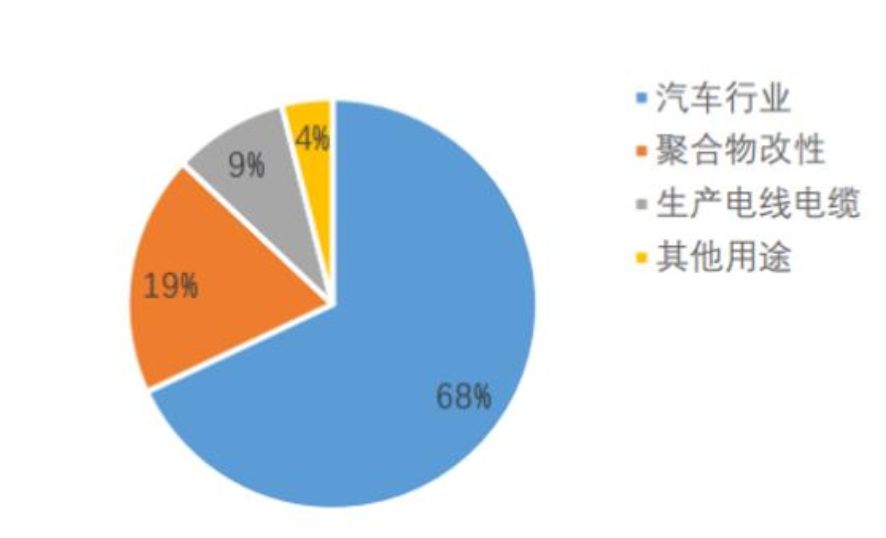
Consumption downstream of POE in China
Comparison of EVA and POE performance
In the photovoltaic field, EVA and POE have their own advantages and disadvantages in terms of performance. EVA is lower in price, easy to process, resistant to storage, fast in cross-linking speed, and has good adhesion performance with glass and backsheet. The advantages of POE mainly lie in its excellent material performance, anti-PID performance, high resistivity, high water vapor barrier rate, and resistance to low temperature and yellowing.
The disadvantages of EVA are primarily that vinyl acetate is prone to hydrolysis in light, oxygen, and humid environments, producing acetic acid, which can corrode the surface of the solar cell and the welding strip. At the same time, it can react with Na in the glass to generate a large number of free-moving Na ions, leading to the decrease of the conversion rate. EVA is also prone to yellowing in a photo-thermal environment, which affects transparency and causes overall power loss of the module.
The disadvantages of POE are that its polarity is relatively low, and the polarity aids in the solvent precipitation on the film surface during the film adhesive process, causing the film surface to be smooth and easily displaced. It is difficult to process, and the film edge is prone to hanging material. POE particles are generally more expensive than EVA particles. It is generally believed that in the next few years, the proportion of POE particles in film particles will increase, mainly due to the following factors:
N-type doping of cells:
The current light-to-electricity conversion efficiency of P-type cells is approaching the upper limit of 24.5%, while the conversion efficiency upper limit of N-type cells is higher. The doping of boron-oxygen compounds in P-type cells in silicon wafers can cause potential attenuation, and the anti-attenuation performance of N-type cells is better. The PID effect of N-type cells is more sensitive to the illuminated surface, and for N-type components with large PID attenuation, irreversible damage can also occur after light recovery. At the same time, when N-type cells are encapsulated with single glass, the backsheet has poor water vapor barrier performance. Therefore, choosing POE film for encapsulation can reduce the overall water vapor transmission rate of the module and extend the module's service life. Therefore, promoting N-type cells can increase POE usage.
Large-scale power generation of cells:
In recent years, the power output of different types of solar cells has increased significantly, resulting in increased heat generation. Temperature can have a significant impact on the peak power, open-circuit voltage, and other electrical properties of cells. Therefore, the electrical performance requirements for encapsulation materials are becoming increasingly high.
Glass cover plate thickness reduction and increasing number of double glass components:
According to CPIA data, the current glass thickness mainly has three levels: <2.5mm, 2.8mm, and 3.2mm. Among them, the market share of glass cover plates with a thickness of less than 2.5mm is 32%, and it is expected to increase to around 50% by 2025. Thinning glass will require increasingly higher performance requirements for encapsulation materials. POE has good mechanical strength and toughness. EPE film can combine the advantages of EVA and POE and is an important direction for the development of film in the future. In addition, the excellent material performance of POE has enormous potential for application in the fields of automobiles, wire and cable, machinery, shoe sole materials, and hot melt adhesives. With the acceleration of localization, POE will cultivate larger market space.
Application of POE
POE direct modification application
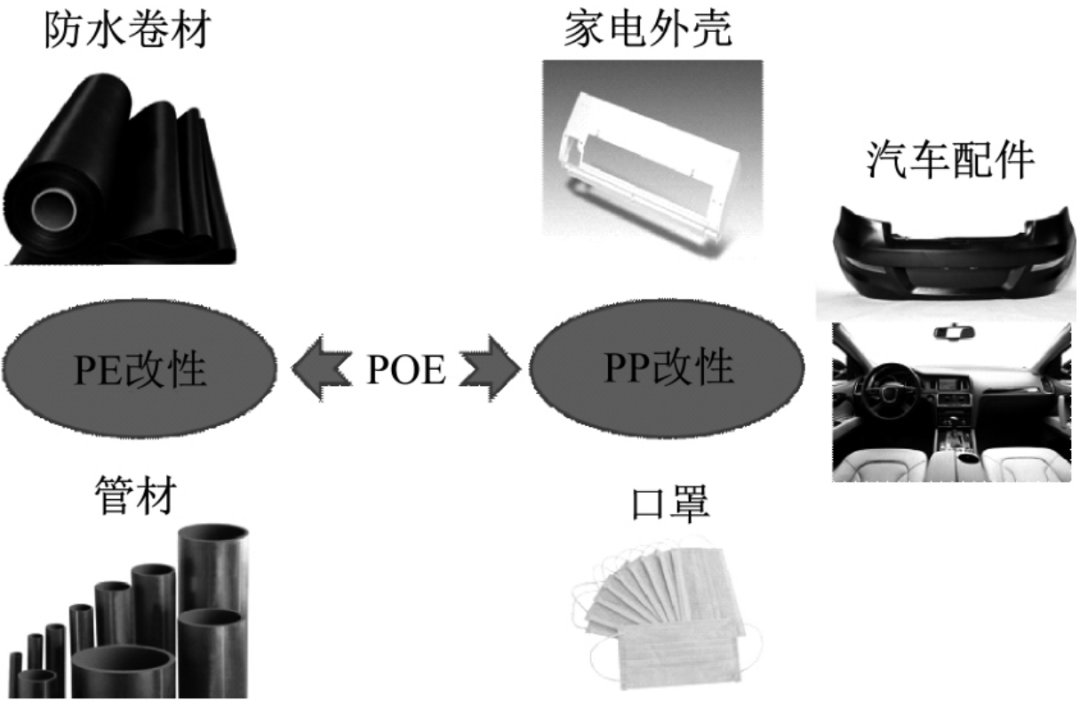
POE direct modification is mainly used for the modification of PP and PE blends.
POE Direct Modification Applications
Due to its low cohesive energy, POE exhibits a temperature-sensitive viscosity and is close to polyolefin resins in terms of morphology. Blending POE with polyolefins results in smaller particle size and narrower particle size distribution, enhancing toughness and impact resistance.
POE has been proven to be a good toughening agent for PP. In the PP/POE blend system, POE forms a "sea-island" structure in the continuous PP phase, effectively improving impact resistance at low and ambient temperatures.
POE direct modification of PP is currently its most important market application, mainly for automotive parts, household appliance casings, and mask production.
POE direct modification of PE is mainly used in waterproofing membrane and pipe production.
PE has high rigidity, poor impact resistance, and low hardness, and must be toughened and modified with POE to achieve target performance requirements.
POE Graft Modification Applications
POE graft modification is mainly used for toughening and modification of PA and polyester polymers.
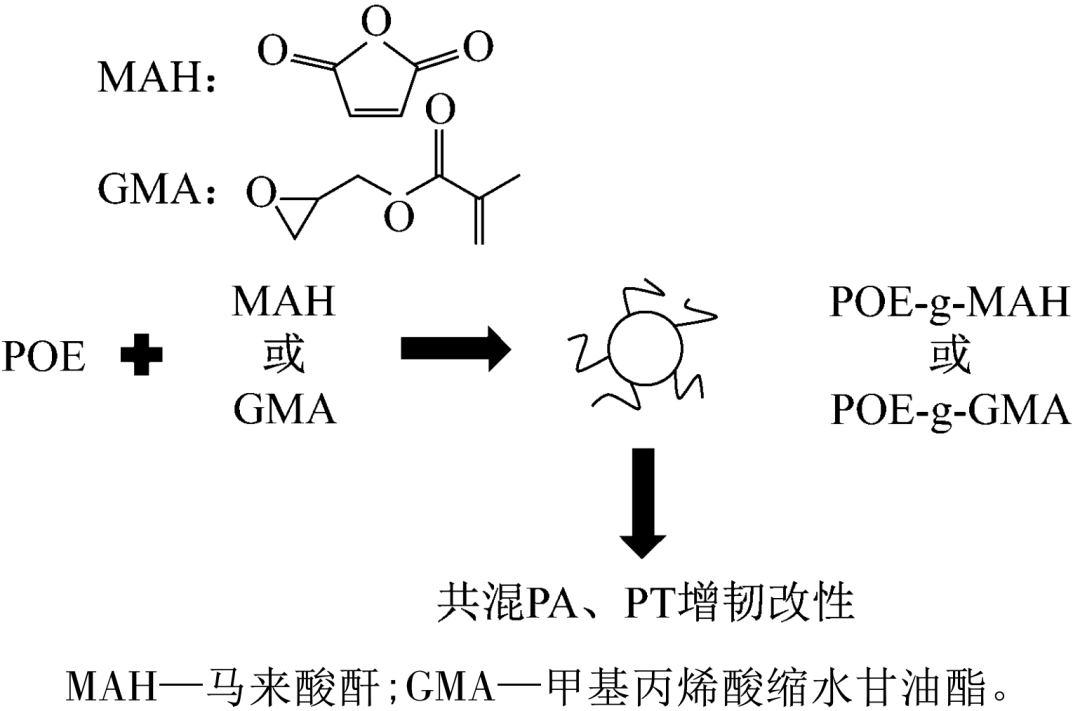
Linear polymers such as PA and PT have main chains composed of strongly polar groups such as amide and ester bonds. These polymers have excellent processability, mechanical performance, wear resistance, chemical resistance, and thermal stability, and are important engineering plastics widely used in construction, machinery, electronics, automobiles, daily necessities, and other fields.
Blending POE with PA and PT is an effective means of improving impact resistance of these polymers.
Due to the strong polarity of the main chain groups in linear polymers such as PA and PT, poor compatibility and severe phase separation occur when blending with non-polar POE. Typically, polar monomers are grafted onto POE molecular chains to improve compatibility with these polymers.
Currently, there are two main forms of POE grafting polar monomers, namely MAH grafted POE and GMA grafted POE.
Foaming Modification Applications of POE
The foaming application of POE is mainly used for modifying EVA. Blending POE with EVA for foaming production of sports shoe soles.
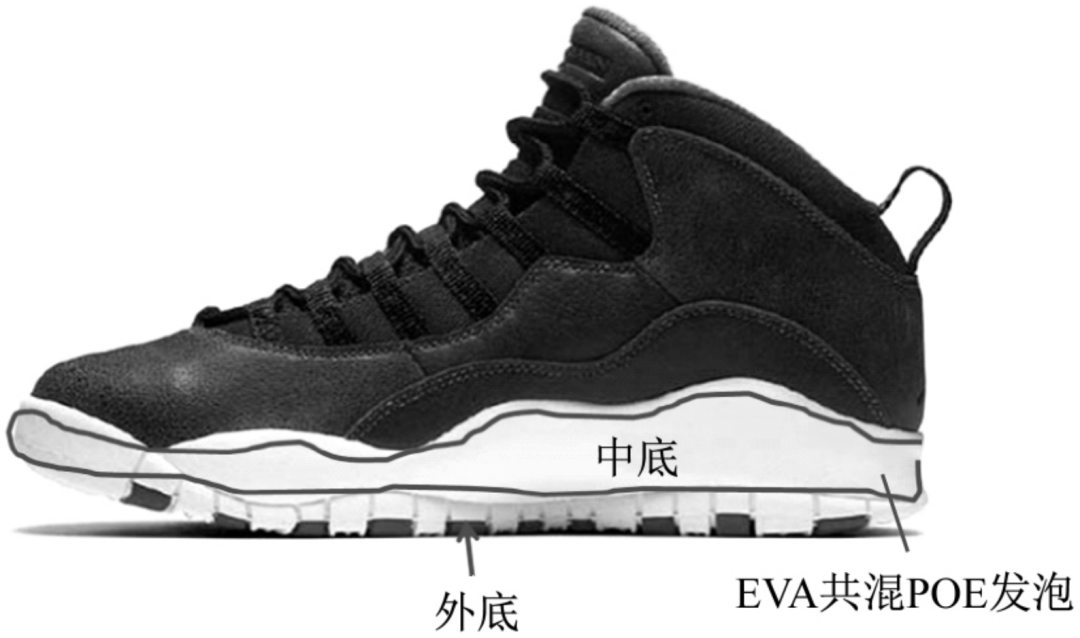
Application of POE Foam Modification
The midsole is the core part of sports shoes, which provides stability, cushioning, and rebound, absorbs the impact generated during exercise to provide protection, and brings a relatively gentle foot feel.
EVA has good flexibility and rubber-like elasticity, and is widely used as a material for sports shoe midsoles.
POE can replace EVA alone as the midsole material for sports shoes, but EVA has a price advantage (30% lower than POE), so POE is more commonly used as a modified material for EVA.
Products made by blending POE with EVA foam have lighter weight, better compression rebound, good feel, even and delicate foam holes, and high tear strength.
Application of POE as a Single Material
POE is mainly used as a packaging material for photovoltaic modules - adhesive film.
In photovoltaic modules, the adhesive film is placed between the module tempered glass/backsheet and the solar cell to encapsulate and protect the cells.
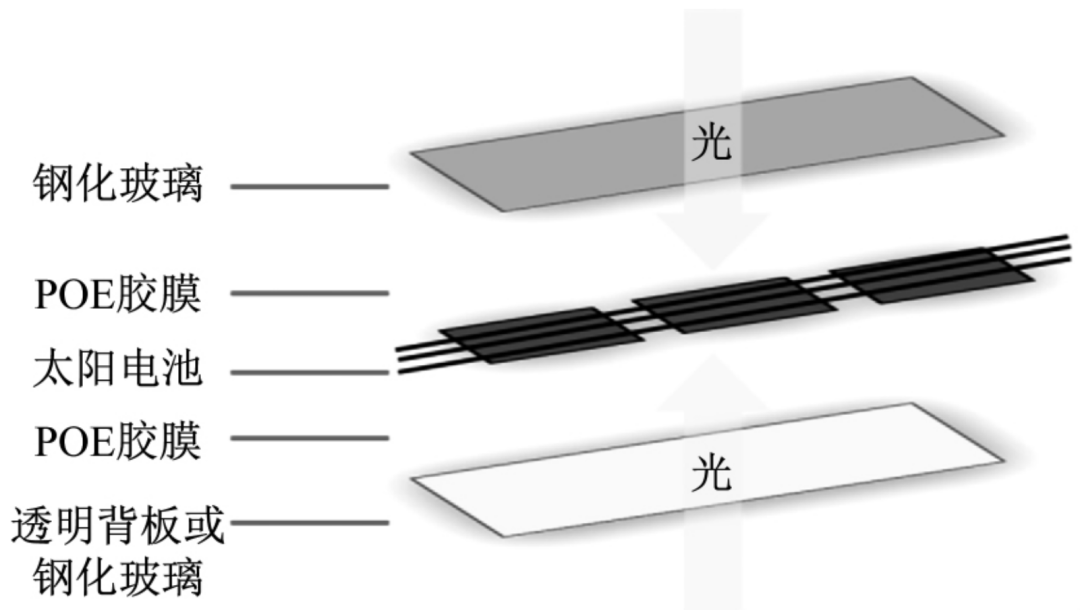
Due to the irreversibility of the solar cell encapsulation process and the requirement for the operating life of the module to be generally over 25 years, any failure of the adhesive film, such as reduced light transmittance or yellowing during operation, will result in the scrap of the solar cell and make the module unusable. Therefore, although the absolute value of the adhesive film in the module is not high, its quality directly determines the product quality and life of the module and solar cell.
Currently, the main packaging films used in photovoltaic modules are EVA films and POE films. EVA films are thermosetting films with low strength, high water vapor permeability and moisture absorption, and poor weather resistance. During normal use, water vapor still passes through, causing the film to become cloudy, affecting the light transmittance, and reducing the power generation of the module. Additionally, EVA films easily decompose and release acetic acid molecules, which corrode glass and backsheet components, shortening the service life of the module. In recent years, it has been found that EVA films have serious potential-induced degradation (PID) in photovoltaic power plants, which leads to a significant reduction in output power.
Compared with EVA films, the biggest advantage of POE films is their low water vapor permeability and high volume resistivity, which ensure the safety and long-term aging resistance of photovoltaic modules in high temperature and high humidity environments and enable the modules to operate efficiently for a long time.

